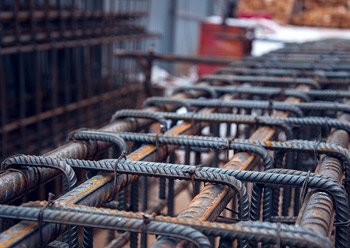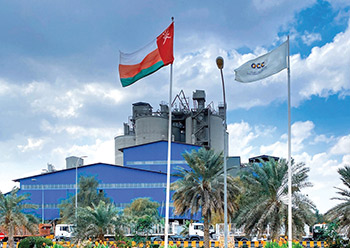
 Rebar ... standards outlined for placement.
Rebar ... standards outlined for placement.
In addition to developing code requirements pertaining to concrete construction, the American Concrete Institute (ACI) produces a variety of manuals, guides, and educational materials designed to help architecture/engineering/construction (AEC) professionals collaborate and adhere to best practices.
In the case of steel reinforcement for concrete members (also known as rebar), several ACI publications provide guidance on the material’s design, fabrication, and placement, notably ACI Code-318-19: “Building Code Requirements for Structural Concrete”, MNL-17(21): “ACI Reinforced Concrete Design Handbook” (pending publication), and MNL-66(20): “ACI Detailing Manual.”
ACI Code-318-19 presents the minimum requirements for design and construction of structural concrete that are necessary to ensure public health and safety; it is addressed to the engineer who is responsible for the structural design work and the development of the contract documents and to the building official who is responsible for enforcing those requirements. The final code requirements of 318-19 are now referenced in the 2021 International Building Code (IBC).
The MNL-17(21) handbook provides general, succinct information to clarify the overall design and detailing requirements of reinforced concrete building structures. It includes design examples of various reinforced concrete members, some of which are based on a fictitious building in order to provide readers with context.
The MNL-66(20) manual provides answers to frequently asked concrete reinforcement detailing questions and is intended for use by design engineers, architects, and engineering students. The manual is divided into three sections:
• Section 1 includes a copy of ACI PRC-315-18: “Guide to Presenting Reinforcing Steel Design Details”.
• Section 2 includes individual details with corresponding checklists.
• Section 3 includes a compilation of articles chosen for their relevance to detailing reinforced concrete.
The manual also includes an appendix with informational tables on nominal cross-section area, weight, and nominal bar diameter; minimum beam width required for bars placed in a beam; properties of bundled bars; and basic development length ratios of bars in tension.
MLN-66(20) Section 1, ACI PRC-315-18 assists the licensed design professional (LDP) in communicating with reinforcing steel detailers, fabricators, and placers. ACI PRC-315-18 offers guidance on presenting all categories of design details and information, including information conveyed through building information modelling (BIM) software. Because structural drawings, along with project specifications, form the bulk of contract documents, ACI PRC-315-18 provides detailed descriptions and examples of drawing content (such as notes, plans, elevations, schedule sheets, diagram sheets and more) as well as recommended page layouts. It includes a recommended order of sheets in the finished drawing set. Information presented in ACI PRC-315-18 is consistent with the requirements and recommendations of other ACI documents, including ACI Code-318, ACI Spec-301, ACI Spec-117, ACI PRC-131.1, and ACI PRC-132.
Bar Design, Placing & Fabrication
LDPs are responsible for the design of concrete members’ cross sections, determining the required reinforcement area, and reviewing bar placement and fabrication shop drawings, including steel bar sizes, quantities, locations, spacing, clearances, cover, geometry, splices, points of termination and tolerances to ensure their compliance with the contract documents.
Tolerances, defined in ACI Concrete Terminology as “the permitted deviation from a specified dimension, location, or quantity,” can have an effect on concrete cover, strength, constructability, and/or serviceability. Nevertheless, permitted deviations are necessary to make concrete construction physically possible and economically practical.
Tolerance considerations are addressed in MLN-66 (20) Section 1, ACI PRC-315-18: Guide to Presenting Reinforcing Steel Design Details, Chapter 3: General Considerations. This chapter urges LDPs to consider combinations of tolerances where multiple types or pieces of reinforcement are placed contiguous to one another. Fabrication tolerances, reinforcement congestion of bars, couplers, headed bars, and other reinforcing bar accessories, as well as formwork, can create placement conflicts that are not readily resolved in the field. The reference document for tolerances is ACI Spec-117-10: “Specification for Tolerances for Concrete Construction and Materials (ACI Spec-117-10) and Commentary-Reapproved 2015.”
During construction, revisions are sometimes warranted either due to changes in the scope of work (often initiated by the owner) or due to unforeseen construction conditions. Therefore, designers are cautioned to pay attention to common trouble spots when revising construction documents: drawing revisions, drawing dimensioning, constructability of the revised work, the use of mechanical connectors, mixing grades of steel on a project, and field cutting and bending of bars.
For drawings, ACI PRC-315 recommends that revisions should be “clouded”; place one cloud around each revision rather than drawing a large cloud around several revisions. Also, if more than one revision is introduced during construction, the design engineer must ensure that all previous clouds are removed from the drawing before initiating a new revision. The LDP should indicate on the revised drawings where mechanical fasteners are to be used, listing specific limitations such as spacing, stagger, and clearance. The type of connector should be listed along with the manufacturer if this is critical. If mixed grades of steel or more than one kind of coating are to be used on a project, the LDP should be specific about where they are to be used. ACI PRC-315 outlines cases where the LDP should set parameters for field cutting and bending of already placed bars.
Recent provisions
ACI standards and provisions are updated to reflect the advancements in materials science. For reinforcing steel, progress in metallurgy has resulted in production of bars that are almost twice as strong as they were several decades ago. Despite this, until recently, building codes limited bar strength based on decades-old research.
Bars being produced today are capable of resisting much greater stresses than previously produced bars of lower grades could. So ACI Code-318-19 included new requirements for material properties of these higher-strength steels and, in turn, changes related to minimum uniform and minimum fracture elongation requirements, and requirements for development and splice lengths of straight high-strength bars as well as hooks and headed bars were added.
Large-scale research programmes have increased our knowledge of the structural behaviour of members and additional data on high steel yield strength, high concrete compressive strength, bar diameter, spacing between reinforcement, and level of confining reinforcement. This data allowed design expressions for the development length of straight bars, standard hooks, and headed deformed reinforcing bars to be harmonised in ACI Code-318-19.
With updates to the code now addressing high-strength bars, it is expected that greater industry adoption of the high-strength bars will occur. This should translate into reduced congestion in heavily reinforced members – a benefit in terms of dealing with tolerance clouds. A greater use of high-strength bars should also result in easier concrete placement and a reduction in time and labour.
For seismic resistance, reinforced concrete special moment frames are designed to have beams, columns and joints that resist moment, axial, and shearing forces. Similarly, special reinforced concrete structural walls are designed to resist these forces. ACI Code-318-19 now permits special moment frames to have ASTM A706 Grade 550 reinforcement and special structural walls to have ASTM A706 Grade 550 and Grade 690 reinforcement. To accommodate these higher grades, additional restrictions on hoop, tie, and stirrup spacing, beam-column joint dimensions and lap splice locations have been added that will contribute to more reliable and ductile performance of special structural systems. The new standard no longer allows Grade 280 steel reinforcement to be used in seismic applications.








.jpg)




.jpg)




























.jpg)

































